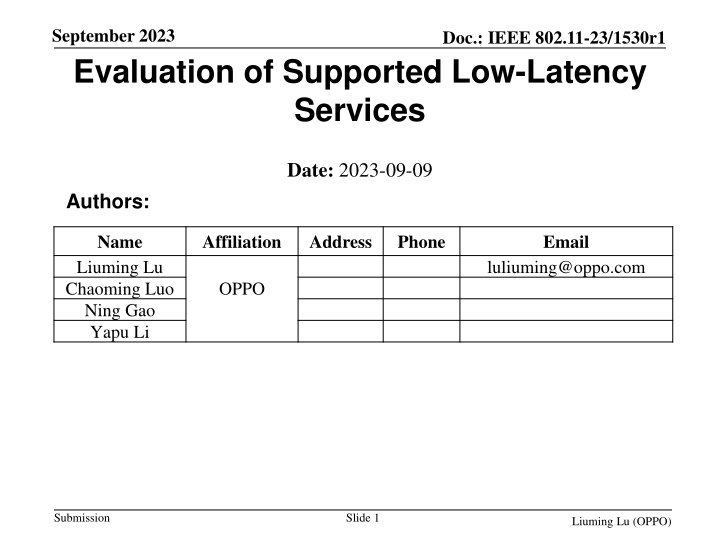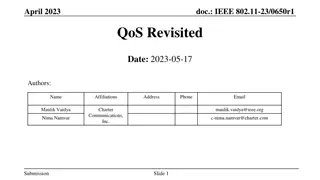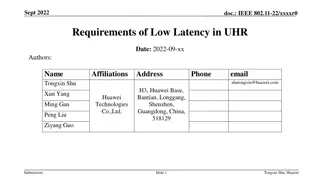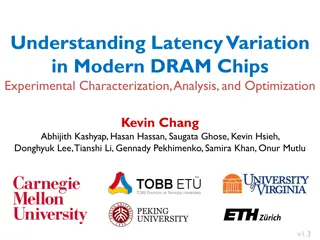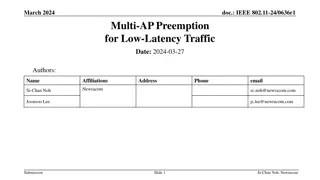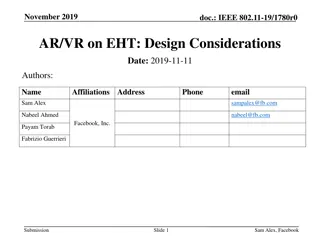Evaluation of Low-Latency Services in IEEE 802.11-23/1530r1
This document discusses the evaluation of supported low-latency services in the context of IEEE 802.11-23/1530r1, focusing on the reliability of WLAN, throughput, latency, and MPDU loss. It addresses the challenges in supporting new low-latency services such as AR/VR and industrial IoT, particularly in Wi-Fi systems utilizing unlicensed bands. The analysis covers factors impacting reliability and proposes evaluation methods for low-latency services.
Download Presentation

Please find below an Image/Link to download the presentation.
The content on the website is provided AS IS for your information and personal use only. It may not be sold, licensed, or shared on other websites without obtaining consent from the author.If you encounter any issues during the download, it is possible that the publisher has removed the file from their server.
You are allowed to download the files provided on this website for personal or commercial use, subject to the condition that they are used lawfully. All files are the property of their respective owners.
The content on the website is provided AS IS for your information and personal use only. It may not be sold, licensed, or shared on other websites without obtaining consent from the author.
E N D
Presentation Transcript
September 2023 Evaluation of Supported Low-Latency Services Doc.: IEEE 802.11-23/1530r1 Date: 2023-09-09 Authors: Name Liuming Lu Chaoming Luo Ning Gao Yapu Li Affiliation Address Phone Email luliuming@oppo.com OPPO Submission Slide 1 Liuming Lu (OPPO)
September 2023 Doc.: IEEE 802.11-23/1530r1 Introduction UHR takes WLAN reliability that focuses on MPDU transfer including throughput, latency and MPDU loss as a main objective. New low-latency services expected to be supported by UHR including AR/VR, metaverse, industrial IoT impose more stringent requirements for high reliability on throughput, latency and MPDU loss In contrast with 3GPP systems, Wi-Fi systems use unlicensed bands that makes the high or ultra-high reliability more challenging as it means that medium access time is unavailable in some time and Wi-Fi systems would suffer from more interferences on their communication. This contribution analyzes the factors that would impact on the reliability to support the low-latency services and proposes a general method for the evaluation of supported low- latency services. Submission Slide 2 Liuming Lu (OPPO)
September 2023 Doc.: IEEE 802.11-23/1530r1 Background Low-latency services have stringent requirements in terms of latency and its jitter along with certain reliability constraints. The traffic typically shows periodic or non-periodic pattern with burst arrival of packets in each interval. According to the characteristics and QoS expectations of a traffic flow, the Minimum/Maximum service Interval and Medium Time as time-dependent parameters for the delivery of packets at burst arrival in each interval have been used to define the QoS requirement of the traffic flow. Submission Slide 3 Liuming Lu (OPPO)
September 2023 Doc.: IEEE 802.11-23/1530r1 Issues The performance of the MPDU transfer for low-latency services is affected by many factors, which can be classified as three categories: AP-side factors: BSS load, available medium access time for specific bandwidth and its distributions, interferences including OBSS interference, the capabilities of AP Client-side factors: interferences including OBSS interference, the expected medium access time assigned to the non-AP STAs, the capabilities of non-AP STAs Other factors: channel conditions, etc. To increase the reliability of MPDU transfer for low-latency services it is important to evaluate: whether it is suitable for special low-latency services based on its characteristics and QoS expectation which factors may cause the unsuitability or bad performance for the services which network configurations needed to make the traffic delivery of the services more suitable or improve the performance, such as the choosing of APs for association, TID- to-link mapping, etc. Submission Slide 4 Liuming Lu (OPPO)
September 2023 Doc.: IEEE 802.11-23/1530r1 Issues Although 11be has specified that non-AP STAs signal a QoS Characteristics element for a traffic flow in an SCS request frame to AP and then receive the SCS response frame from AP to know whether the delivery of the traffic flow is accepted by AP, the mechanism is not enough for the evaluation of supported low-latency services. The mechanism requires the non-AP STAs to firstly be associated with the AP. If non-AP STAs expecting low-latency services need to choose which AP/BSS is suitable to join, the mechanism is not useful If the SCS request with QoS characteristics element is rejected by AP through SCS response, no enough information is provided for non-AP STAs to know which factors may cause disallowance of the expected low-latency services, AP-side factors or client- side factors, or others? Furthermore the information provided by currently specified beacon and probe/association response is not enough for non-AP STAs with expected low-latency services to make a decision on which AP it is suitable to join. Submission Slide 5 Liuming Lu (OPPO)
September 2023 Doc.: IEEE 802.11-23/1530r1 Issues BSS load element carries no enough information for the evaluation of supported low-latency services. For BSS loads in measurement period a) and b), although the aggregate available time (i.e. available admission capacity specified in BSS load element) is the same, the distribution of the available time is different from each other, which means that the support for special low-latency services is different. t t Available service time Available service time Available service time Available service time Service interval of available service time(A Service interval of available service time(A- -SI) SI) a) QoS parameters measured in one measurement period a) QoS parameters measured in one measurement period t t Available service time Available service time Available service time Available service time Available service time Available service time A A- -SI 2 SI 2 A A- -SI 1 SI 1 b) QoS parameters measured in the other measurement period b) QoS parameters measured in the other measurement period SPs for R SPs for R- -TWT Schedule 1 TWT Schedule 1 (Service time is fully occupied) (Service time is fully occupied) SPs for R SPs for R- -TWT Schedule 2 TWT Schedule 2 (Service time is fully occupied) (Service time is fully occupied) SPs for R SPs for R- -TWT Schedule 3 TWT Schedule 3 (Service time is fully occupied) (Service time is fully occupied) Beacon Beacon the support for best-effort services may be similar as the best-effort services are non-latency-sensitive services, which means that the service traffic can be delivered in any available service time For low-latency services, the service traffic needs to delivered in limited time dependent on delay bound, and if the available service time is not enough for the delivery of the packets in a burst and the start time of the next available time is too later, the requirement for the delay bound would not be met. Submission Slide 6 Liuming Lu (OPPO)
September 2023 Doc.: IEEE 802.11-23/1530r1 Candidate solutions A tool is needed to evaluate whether it is suitable for special low-latency services, or which factors may cause the unsuitability or the bad performance for the services, or which network configurations are needed to improve the performance The evaluation mechanism of supported low-latency services based on AP scheduling capability can be considered. available Minimum service duration available Maximum service duration available Minimum service interval available maximum service interval 1. Evaluation of available service time parameters based on AP scheduling capability and channel conditions 2. Evaluation of the QoS characteristic parameters of service flow supported by AP QoS parameters evaluated to be supported 3. Evaluation of recommended capabilities and operation parameters for non-AP STAs recommended capabilities Recommended operation parameters Submission Slide 7 Liuming Lu (OPPO)
September 2023 Doc.: IEEE 802.11-23/1530r1 Candidate solutions At each measurement period (such as several beacon intervals) , QoS parameters (available Minimum service duration, available Maximum service duration, available Minimum service interval, available Maximum service interval, etc.) can be evaluated When there is evaluation information for supported low-latency services, the information can be announced in transmitted Management frames, such as beacon frames, probe/association response frames Carries the evaluation Carries the evaluation information for supported information for supported low low- -latency services latency services t t Available minimum service duration Available minimum service duration Available service time Available service time Available maximum service duration Available maximum service duration available Minimum service interval available Minimum service interval available Maximum service interval available Maximum service interval Channel busy/Interference time Channel busy/Interference time Available medium time Available medium time Submission Slide 8 Liuming Lu (OPPO)
September 2023 Doc.: IEEE 802.11-23/1530r1 Summary New low-latency services impose more stringent requirements for high reliability on throughput, latency and MPDU loss. And Wi-Fi systems use unlicensed bands that makes the high or ultra-high reliability more challenging. A mechanism for the evaluation of supported low-latency services is suggested to be specified for UHR to support high reliability. Submission Slide 9 Liuming Lu (OPPO)
September 2023 Doc.: IEEE 802.11-23/1530r1 Reference [1] UHR proposed PAR, https://mentor.ieee.org/802.11/dcn/23/11-23-0480-03- 0uhr-uhr-proposed-par.pdf [2] Laurent Cariou, Improved reliability in presence of interference, https://mentor.ieee.org/802.11/dcn/23/11-23-0298-00-0uhr-improved-reliability-in- presence-of-interference.pptx Submission Slide 10 Liuming Lu (OPPO)
September 2023 Doc.: IEEE 802.11-23/1530r1 SP SP : Do you support to specify the mechanism for the evaluation of supported low-latency services in UHR? Submission Slide 11 Liuming Lu (OPPO)
